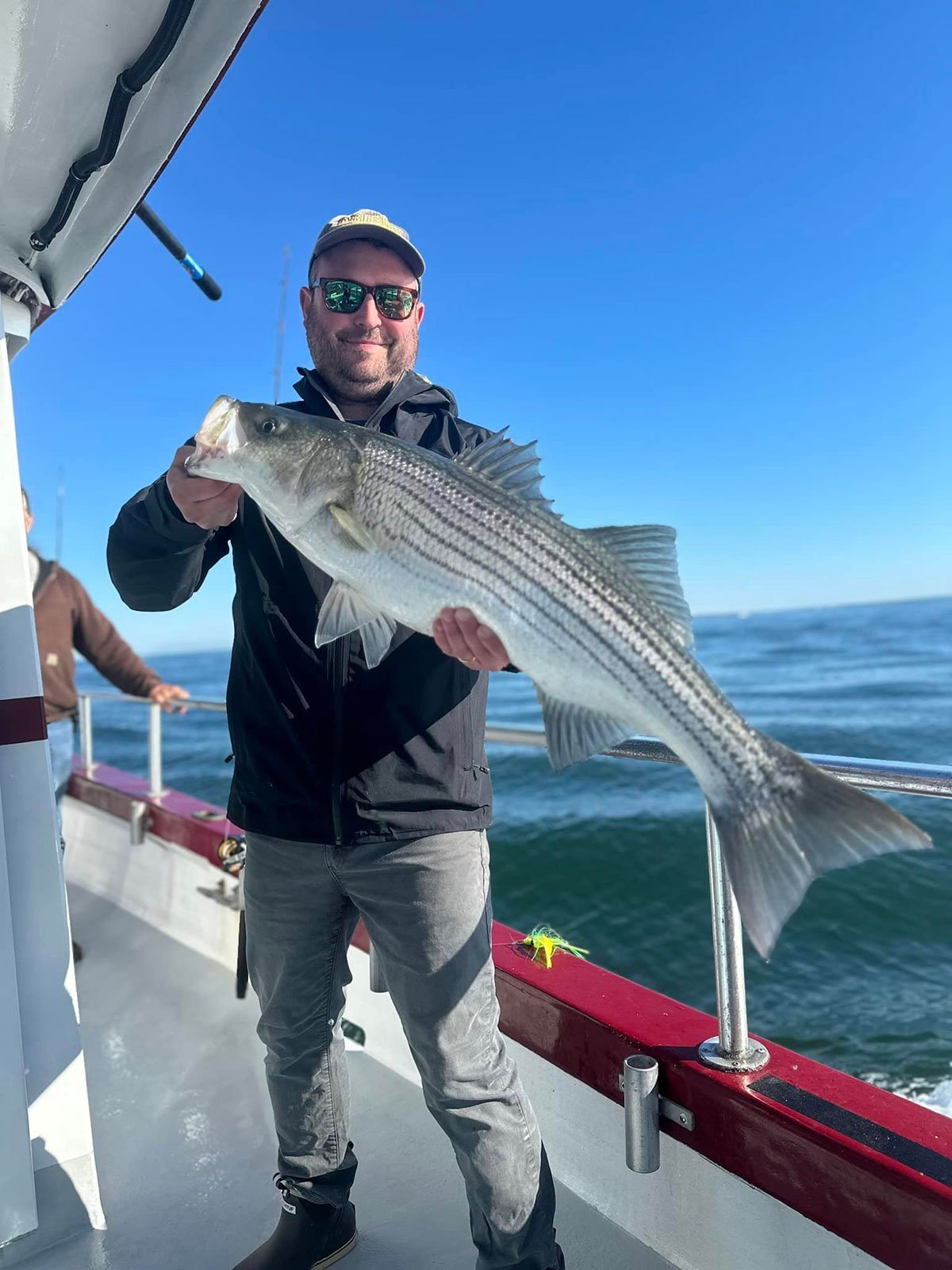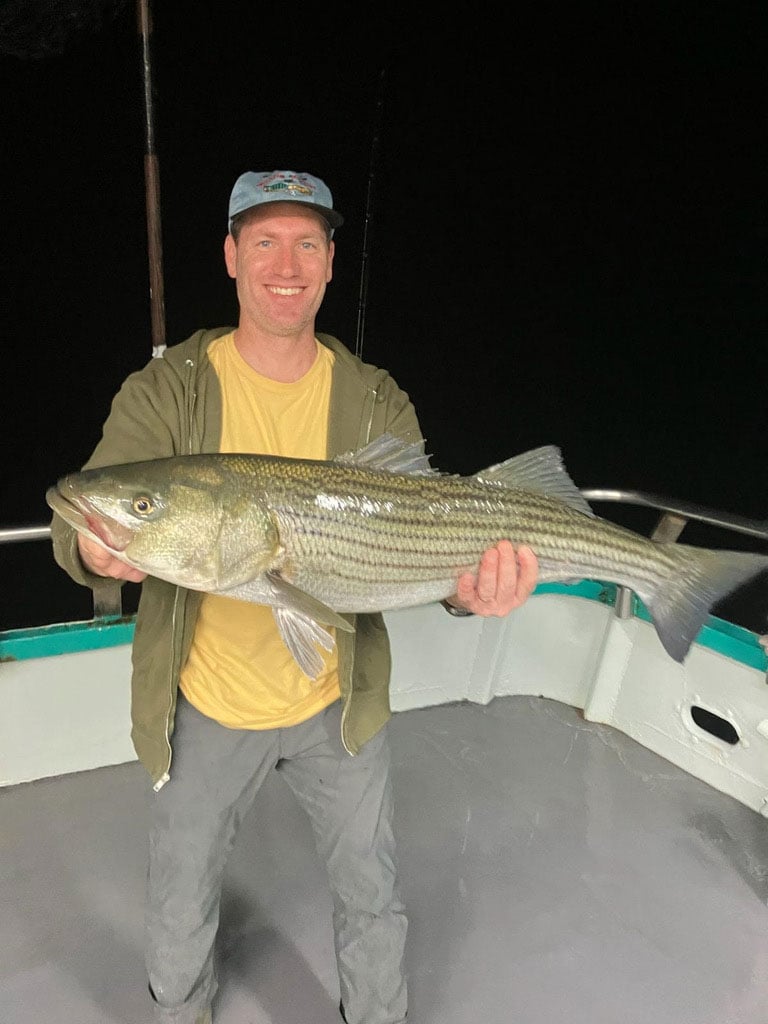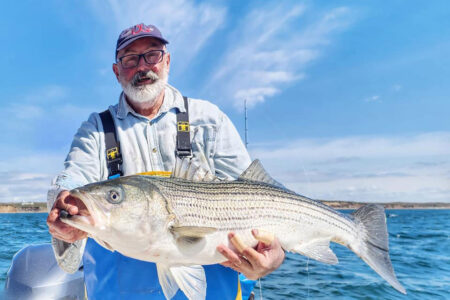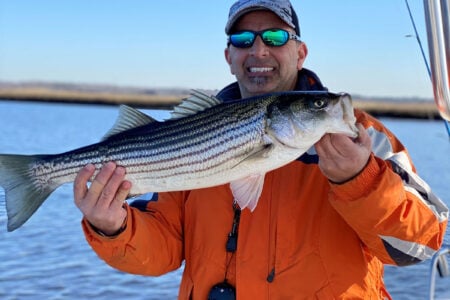
The month known to produce some of the largest stripers of the year.
Some of the great striper fishing the area had in June continues into July and usually remains so until the water gets too warm, which usually occurs sometime during the latter part of the month. There are some places, though, that will hold their good fishing for the entire duration.
The NY Bite, including North Jersey, should be really slow. This is primarily a spot on the migration route anyway, which is usually hot when the stripers pass through in the spring and again in the fall.
Long Island Sound
The Western Sound can have some excellent fishing as we start the month, but as the days and the heat progress, the fishing can really taper off. Cinder Worm swarm fishing around the Spring tides will be good; in fact, the Western Sound will have its most prolific worm swarms and, consequently, the best bass fishing in them this month. This will happen at night on the falling tide and is certainly something to look for. Even when in the worms, as the water temp goes above 72 degrees, bass make themselves scarce, as oxygen levels become critical.
Look for cinder worm swarms in and around estuaries, back-in areas, salt pond outlets, and creek and river mouths. Check your favorite harbor, too. If there are bass around, they will be on these worms.
East of the Western Sound, going on into Eastern CT, across to Orient Point, over to Montauk, and even including Long Island’s ocean facing South Shore, bass fishing will taper off quickly, if not suddenly after the water temp rises above 70 degrees.
Below 72 degrees (in Western Sound), the Norwalk islands should remain good. Same for Middle Ground. Smithtown Bay should have some sand eel-eating bass, with fish roaming the shallow sand flats as well. Penfield Reef, the Thimble Islands off Branford, CT, and around Clinton, CT, should have fish too. Fishing should remain good around the Triangle and Buoy 11B off Northport as well. This specific spot is the rare area that can have lots of fish even after temps rise above 72 degrees.
Temps may remain cool enough in the far Eastern Sound all month, so areas around Groton, New London, Watch Hill RI, the Race, Orient Point, and running over to Montauk can sustain good fishing as July’s weeks pass. Night fishing in these areas will be good, too. If temperatures are cool enough (below 70 degrees), night fishing along Long Island’s South Shore beaches can be productive as well.
Eastern Bays
Flats fishing in Shinnecock, Moriches, Peconic, and Gardiners Bays can be good until, you guessed it, that water temp gets up there. This usually means you’ll have at least some good July fishing in these places.
Come the end of July, if everything is too hot, there’s one place that will not, and that’s the Race, located from Race Rock off Fishers Island, all the way over to Orient Point and Plum Island. It’s the mouth of Long Island Sound. It’s usually a fish refuge in the heat.
Generally speaking, spots that were productive in June will remain that way until the water temp gets too warm, or if the bass have already migrated through.

Montauk And Beyond
Now, there are two places that will not only remain good but will perhaps offer even better fishing this summer than they did the last.
Iconic Montauk should have lots of bass, including big bass all month long. Of course, there are ebbs and flows to the fishing here as the days and weeks proceed, but things can be good anytime from the 1st to the 30th. You just have to be lucky enough to be there when the bite is on and the fishing hot. It’s fortunate that that can happen here often. If it’s not, be perseverant! The best fishing will be in the rips on the bottom and sometimes here on top, too. The south side can produce as well. Montauk often gives up (traditionally) its biggest stripers in July, and you can catch them on anything: bait, trolling parachutes and Mojos, plugs, flutter spoons, bucktails, soft plastics, and flies, too. When it comes to methods, lures, and baits during this seventh month of the year, Montauk is democratic.
Hotspot Number two is that wonderful shoal sitting out in the middle of the open ocean off Block Island, Southwest Ledge. It can be a bass Mecca and a big bass Mecca in July, day or night. Great (stellar?) fishing can happen here, even in the middle of a hot, cloudless day. Something not too common in other places in the middle of the summer. Try your luck with live eels, bucktails, soft plastics such as Super Snacks, diamond jigs, live baitfish, poppers, Docs, other plugs, swimbaits, or flutter spoons. Put your time in, learn the area, and you will be rewarded. You’ll do best by fishing that bait or lure just off the bottom, but you can, at times, score on surface lures (or shallow running baits), especially if fish are breaking.
Want to catch the biggest bass of your life? Try fishing on or around the July full moon (and new moon) at Montauk or Southwest Ledge, especially at night. Historic monster linesiders have been caught here at this time. Maybe your name is destined for the books!
Additional Cinder Worm Findings
With the Cinder Worm swarms peaking this month, especially in Western LI Sound, I want to say something about this especially intriguing phenomenon.
A friend of mine, Jay Bobowitz, and I went to great lengths to find accurate information that was acquired from scientific research on this worm because all we could find out about it beforehand, and for too long a time, was folklore and banter from fishermen. This was 30 or more years ago, and it’s dismaying that so much folklore (in print and video) still widely exists, as well as scientific claims that don’t check out. The findings come from research done at Woods Hole and correspondence with a German scientist with expertise in the worm, as well as other sources. Both Jay and I exhaustingly checked the findings for accuracy over countless nights over many years.
The cinder worm activity we see is mating behavior by adults, and it’s a swarm, not a hatch. There’s no metamorphosis involved, like with insects. Swarming happens on the outgoing tide only and almost only at night in the Western Sound. And even if it can happen on any night after the water temperature gets above 60 degrees, it happens best around the new and full moons. Since I also found surprising worm activity on the night of the quarter moon, I determined that it’s not the tide level that stimulates the worms, but the activity of the ecosystem. This is moon-related. The swarm will usually last for 2 1/4 hours, after which the worms will go back down to (and into) the benthos (the top of the bottom), which is where they live. They swarm for two 21-day cycles (starting in June in Western LI Sound, in some warm salt ponds here in May), after which (sometimes at the end of each cycle, but definitely after the second) the worms will stay up and not go back to the bottom and will wash out with the tide into the next day. This usually signals the end of the cinder worm swarming for the year (at least for the VAST majority of them).
They are usually from 1 to 3 ½ inches in length and are olive and reddish in color. A white worm is a female laden with eggs – the eggs are white. They can swarm by the hundreds, the thousands, and what looks like, at times (when they cover an entire harbor), the millions during a “blown out” swarm! Again, you find them in estuaries, river and creek mouths, salt ponds, and salt pond outlets, inside harbors, over shallow shoals, and around islands. They like a mud/sand bottom and are “photophilic,” meaning they are drawn to the light, such as dock lights and the moon. A calm, flat, hot & humid (misty) night encourages the best swarming –When does this most happen? In July! Cold, wind, and rain put them off. Once that water temperature gets over 72 degrees – in some more recent years, they have swarmed in temps to 76 degrees – but 72 is usual, and they cease swarming, usually for the year.
The swarm is moon and temperature-related. Cinder worms are Nerus worms (Genus), and marine Nerus worms are common worldwide. The “Palolo” worm of tarpon fishing fame in the Florida Keys is a Nerus. Our worm locally is eaten by not only bass but by all fish able to eat it (flounders, fluke, bluefish, porgies, you name it), ducks, raccoons, herons, and more too. To fish it, use a fly rod with a floating line, a long leader, and a cinder worm pattern, or try a small red or black soft plastic curly tail with a light spinning rod.
We still have some great bass fishing in our region in July. It’s a time when you can get the biggest striper of the year, perhaps even the biggest of your life. Or maybe you’d like to witness and fish the mysterious and intriguing cinder worm swarm. It’s all happening here in July!



